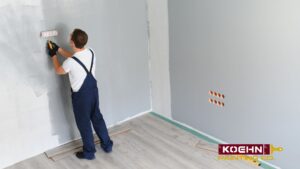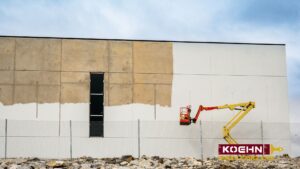Table of Contents
TogglePainting over wallpaper might sound like a tricky task, but it doesn’t have to be. Whether you just moved into a new home or you’re simply tired of your old wallpaper, painting over it can be a quick fix to refresh your space without the hassle of removing the wallpaper, which can be quite expensive.
The good news is that, yes, you can paint over wallpaper. However, there are a few key steps you’ll want to follow to make sure the paint job looks clean and lasts a long time. It’s not just about grabbing a paint roller and going to town—you need to know how to paint over wallpaper to get things right. Each step makes a big difference in the final result, from checking if the wallpaper is in good condition to applying the right primer.
Did you know that wallpaper can last up to 15 years with proper care? This is one reason why some homeowners consider painting over wallpaper rather than removing it. It’s time-saving and cost-effective, especially when the wallpaper is in good condition.
Another interesting fact is that some wallpaper can act as a thermal insulator, saving up to 5% on energy bills by helping to retain heat in the winter and keeping rooms cooler in the summer.
This guide will walk you through all the basics so you can feel confident about the process and know when it might be best to call in a professional painter to get the job done right.
Ready to learn all you need to know about painting over wallpaper? Let’s dive in!
Can You Paint Over Wallpaper—and Should You?

The idea of simply painting over it might seem like an easy fix, but the real decision isn’t just about whether you can paint over wallpaper—it’s also about whether you should and how to paint over wallpaper without damaging it completely.
Yes, painting over wallpaper is possible, but there are some factors you need to weigh before jumping in. The first thing to consider is the condition of your wallpaper.
- If it’s peeling, damaged, or has bubbles, painting over it could end up accentuating those imperfections. The paint might make the wallpaper look worse, with visible seams and uneven textures. So, if your wallpaper is in poor condition, it might be best to remove it altogether before picking up a paint roller.
- On the other hand, if your wallpaper is in good shape, painting over it can be a time-saver and a cost-effective option. It saves you the labor-intensive task of stripping the wallpaper, which can sometimes damage your walls. Painting over well-adhered wallpaper gives you the chance to quickly update your space with minimal fuss. Just keep in mind that wallpaper often has patterns and textures that may show through the paint, especially if you’re using a lighter color. In that case, applying a thick, high-quality primer can help smooth things out before adding your final coat of paint.
- Another consideration is the long-term plan for your home. If you’re just looking for a temporary fix or want to give your home a facelift before selling it, painting over wallpaper might be a good solution. It allows you to freshen up the walls without too much commitment.
Once wallpaper is painted over, it can be even more difficult to remove later on. The paint locks it in place, and stripping it becomes a more complicated task. So, think ahead about how long you plan to keep the new look and how much effort you’re willing to put into the process:
While painting over wallpaper is possible, it’s not always the best option. If you’re after a long-lasting, high-quality result, removing the wallpaper might be a better choice. Either way, preparing the surface properly and using the right products will make a significant difference in the final outcome.
Contact us here if you would like to find the best painting contractor for your residential or commercial painting needs.
How to Paint Over Wallpaper

So, the key to success lies in how well you prepare and choose the right materials for your paint over wallpaper job. But there are some important points to consider about how to paint over wallpaper properly. The wallpaper should be clean, smooth, and firmly attached to the wall.
Let’s start with the first question: what kind of paint do you use to paint over wallpaper? You need to make the choice before even starting the whole process. Well, the answer is that you should start with a primer, not with paint. When painting over wallpaper, an oil-based or shellac-based primer might be necessary to seal the surface, especially if you’re covering patterned or textured wallpaper.
This primer will prevent moisture from reaching the wallpaper adhesive, reducing the chance of peeling or bubbling. After priming, you can use latex or oil-based paint, but oil-based paint tends to provide better durability and adhesion in this scenario. Experts also advise to use a flat, or matte paint, as it offers way more coverage than the others.
Can you paint over wallpaper with a clear water-based coat? You have some left after painting your wood shelf, so why not put it to good use? You may, but the results might not be up to your liking, especially if the coverage is what you are looking for.
If your wallpaper has dark colors or patterns, it’s best to choose a darker paint shade. For a lighter color, apply a primer and multiple coats to fully cover the design. You can test in a hidden spot to see how many layers are needed.
Another question: How to paint over wallpaper without primer? While it’s generally advised to prime the wallpaper before painting, it is possible to paint over wallpaper without primer. However, skipping this step increases the risk of the wallpaper lifting or the pattern showing through the paint. To compensate, you can use multiple coats of thick, high-quality paint or consider using paint with built-in primer.
So here is the pretty straightforward process:
- Wash the Wallpaper:
Start by cleaning the wallpaper using a mild solution like trisodium phosphate (TSP) mixed with water. Because TSP is a strong cleaner, you’ll need to dilute it properly for safe use.
Mix approximately half a cup of TSP with two gallons of warm water to create a solution that’s effective for cleaning but not too harsh on your surfaces. Make sure to stir the mixture well until the TSP dissolves completely. When using this diluted solution, wear gloves to protect your skin and be sure to rinse the surface thoroughly with clean water after cleaning to remove any residue.
Gently scrub the surface with a sponge to remove dust, dirt, and grime.
In addition to TSP, several other cleaners can be used on wallpaper:
- Dish Soap and Water: A gentle mixture of dish soap and warm water can effectively remove dust and mild stains without damaging the wallpaper.
- Vinegar and Water: A solution of vinegar and water (1:3 ratio) is a natural cleaner that works well for cleaning grime without harsh chemicals.
- Wallpaper Cleaner: Commercial wallpaper cleaning products, like Goo Gone or Zep, are designed specifically for safely cleaning wallpaper surfaces without causing damage.
- Magic Eraser: For tougher stains, a Mr. Clean Magic Eraser can be gently used on washable wallpaper.
- Ensure the Wallpaper is Attached:
Check for any loose or peeling sections of wallpaper. If you find any, use wallpaper seam glue to secure the edges. Apply the glue with a small brush, press the edges back against the wall, and smooth them down with a wallpaper roller to eliminate bubbles and creases. Allow the glue to dry before moving forward. - Apply Primer:
An oil-based primer is essential to prevent the wallpaper pattern from bleeding through the paint. Using a roller, apply the primer evenly across the entire surface. Products like Zinsser Cover Stain are excellent for this task. Let the primer dry thoroughly, which may take several hours depending on the brand you use. This step ensures that the paint adheres well and covers the wallpaper design completely. - Paint the Wall:
After the primer is dry, it’s time to apply the paint. Use a high-quality latex paint, and apply two coats for full coverage. Use a roller for large areas and a brush for corners or edges. Allow each coat to dry fully (typically 2-4 hours) before applying the next one. This ensures a smooth, even finish. - Dealing with Textured Wallpaper:
If your wallpaper has a lot of texture or embossing, you may need a thicker primer like Kilz Premium to cover the patterns. You might also need multiple coats of paint to get a smooth finish. Even with extra coats, some texture might still show through, so consider whether you want to embrace the textured look or continue layering paint to reduce it. - Final Smoothness:
Keep in mind that even with a thick primer and multiple layers of paint, the texture may not completely disappear. If a smooth, modern finish is what you want, you may need additional layers or thicker products. However, some homeowners embrace the textured look as part of their design.

By following these steps and using the right products, you can paint over wallpaper and achieve a professional-looking finish.
How to Paint Over Wallpaper: Conclusion

It’s entirely doable with the right materials, proper preparation, and a bit of patience. For homeowners looking to update their walls without dealing with the hassle of removing wallpaper, this can be an appealing option.
While it may seem simple, it does require attention to detail and the right approach to ensure that the results are smooth, clean, and long-lasting. If you’re not fully confident in your abilities or feel unsure about the condition of your wallpaper, calling in a professional painter can be the smarter choice.
Advantages of Hiring a Professional Painter:
- Expertise and Experience: Professional painters bring years of experience to the table. They can assess the wallpaper’s condition and determine the best course of action. For example, they’ll know whether it’s safe to paint over the wallpaper or if it’s too damaged or textured to achieve a quality finish. Their expertise ensures that potential issues—like peeling or bubbling—are addressed before they become bigger problems.
- Proper Preparation: Preparation is everything when painting over wallpaper. From securing loose edges to applying the correct primer and ensuring a smooth base, professional painters know the exact steps to follow for optimal results. They also have the right tools to handle challenging areas, like corners or seams, where wallpaper tends to lift.
- High-Quality Materials: While many homeowners might go for a standard primer and paint, professionals have access to higher-grade products that offer better coverage and durability. This includes specialized primers that can seal the wallpaper and prevent any patterns or textures from showing through. Using the right materials ensures that the final paint job lasts longer and looks better.
- Time Efficiency: Painting over wallpaper can be a time-consuming process, especially for those unfamiliar with it. A professional can complete the job much faster, with a more polished result, freeing up your time for other things. You won’t have to worry about mistakes or having to redo parts of the project.
- Long-Lasting Results: One of the biggest advantages of hiring a professional is peace of mind. When done right, a professionally painted wall can last for years without issues like peeling or cracking. You can trust that the job will be done correctly the first time, leaving you with a high-quality finish that holds up over time.
If you’re considering whether to take on the project yourself or call in the pros, Koehn Painting is an excellent option. With a reputation for high-quality work and a deep understanding of residential and commercial painting needs, they ensure that the job is done efficiently and to the highest standards. Whether your wallpapered walls need a quick refresh or a more involved restoration, Koehn Painting can help transform your space with a flawless, professional finish that you’ll love for years to come.
Discover the Koehn Painting difference – contact us today for a free estimate and step into a vibrant, freshly painted home!





